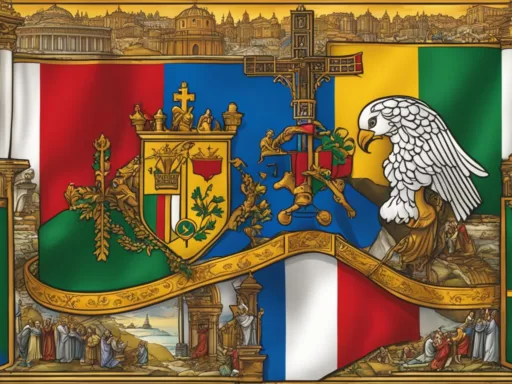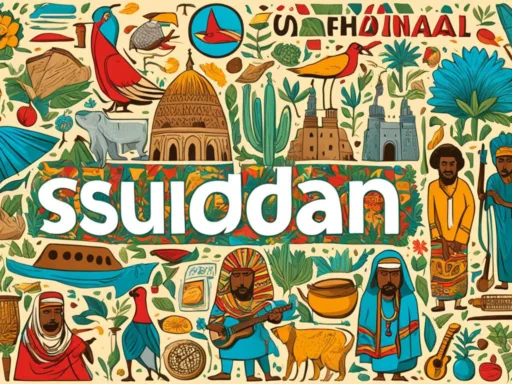Beyond the iconic Spanish flamenco and tempting tapas, Spain is a linguistic powerhouse with a staggering count of languages – did you know that there are at least five official regional languages in Spain? The tapestry of tongues that unfolds across this European country includes, aside from the nationally dominant Spanish, a fascinating mix of regional languages such as Catalan/Valencian, Galician, Basque, and even the less globally known Aranese. This multifaceted linguistic landscape of Spain is not just a matter of local pride but a reflection of the country’s rich cultural and historical fabric. Each language and dialect is a testament to the various influences that have shaped the Iberian Peninsula over centuries. Let’s delve into the regional languages of Spain and explore the vibrant, often unexpected side of this nation’s linguistic heritage.
Understanding the languages spoken in Spain is like peering into a kaleidoscope of cultures and histories, each more colorful and detailed than the last. From the soothing lilts of Galician echoing Portugal’s melodies to the individualistic beats of the non-Romance Euskara (Basque)—every sound bite tells a different story. And that’s before we even consider the immigrant languages enriching the contemporary Spanish society, lending their notes to an already diverse chorus. Join us as we embark on a linguistic journey that stretches from the Pyrenees to the sun-kissed shores of the Mediterranean.
Key Takeaways
- Spain’s linguistic diversity is much broader than many realize, with a surprising number of regional tongues.
- The **linguistic landscape of Spain** includes not only Spanish but also Catalan/Valencian, Galician, Basque, and Aranese as official regional languages.
- Historical connections and migrations have graced Spain with a linguistic palette that extends into immigrant languages.
- Each regional language of Spain carries its own cultural significance and offers a unique insight into the country’s history.
- Languages like Basque challenge linguistic classification, adding to the mystique of Spain’s cultural composition.
- The recognition of minority and immigrant languages reflects Spain’s commitment to cultural diversity and inclusion.
The Multilingual Tapestry of Spain
Embarking on a journey through Spain’s linguistic heritage is like unraveling a vibrant tapestry, woven from threads of invasions and dominions that have shaped this Iberian nation. The historical ebb and flow have fostered a unique constellation of languages, creating a rich multicultural dialogue within its borders.
The Influence of Spain’s Diverse History on its Languages
Spain’s chronicles are marked by conquests and settlements that have introduced a wide array of lingual influences. The romance of Spanish, with its mellifluous sounds and lyrical rhythm, echoes the country’s Roman past, while the linguistic imprints of the Visigoths and Moors still whisper in its vocabulary. This intermingling of civilizations has bequeathed Spain with an extraordinary linguistic legacy, in which even the paintbrush of modernity could not homogenize.
Regional Identities through Language
In the heart of Spain’s diversity, regional languages such as Catalan, Galician, and Basque epitomize the strong cultural identities that flourish within the nation. These languages are not mere relics of history; they are living, pulsating entities that invigorate the soul of each region. As Romance languages, Catalan and Galician share the warmth of their linguistic brethren, while Basque stands apart as a mysterious language isolate, untethered by common roots.
Amidst this linguistic mosaic, Spanish or Castilian Spanish claims its status as the only tongue that unfurls its vibrancy throughout the entire country. Below is a representative table of Spain’s primary regional languages and their respective autonomous communities.
| Language | Region | Official Status | Family |
|---|---|---|---|
| Spanish | Nationwide | Yes | Romance |
| Catalan | Catalonia, Balearic Islands, Valencia (as Valencian) | Yes | Romance |
| Galician | Galicia | Yes | Romance |
| Basque | Basque Country, Navarre | Yes | Language Isolate |
Languages Voiced Across the Iberian Landscape
On the vibrant Iberian Peninsula, particular languages are not merely means of communication but steadfast symbols of regional identity and cultural nuance. The mosaic of Spanish autonomous communities each holds its enduring legacy, echoing through the languages they protect and embrace. Whether showcasing the robust pride of Aranese in the valleys of Catalonia or the melodious rhythms of Fala within the western borderlands, Spain’s commitment to linguistic diversity is palpable.
Distinct Languages and Where They are Spoken
Each Spanish autonomous community presents a linguistic tapestry as diverse as its landscapes. In the heart of the Pyrenees, Aranese flourishes within Catalonia, holding a special place as one of the least spoken yet ferociously protected languages. Aragonese whispers through the rugged expanse of the Aragon mountains, while Asturleonese can be heard in the towns of Asturias and León, recounting tales as old as the regions themselves.
Not to be overlooked, the Canary Islands boast the enrapturing Silbo Gomero, a language of whistles that cascades down the gorges, a testament to human ingenuity and adaptation. Fala, a member of the Galician-Portuguese group, is spoken in the serene valleys of the Extremadura and is held dear by its inhabitants.
Understanding Spain’s Autonomous Communities
The spread of languages across the Iberian Peninsula is not just about communication but about heritage and cultural identity. This intricate web of dialects and languages exudes the rich history and community spirit of Spain’s varied territories. While the more widely known tongues like Catalan, Basque, and Galician receive international attention, the steadfast efforts of local communities to sustain and celebrate the bond they share with their language are truly compelling. From school curricula that incorporate Aranese to folk festivals that applaud the resilience of Aragonese and Asturleonese, Spain shows a relentless dedication to its eclectic chorus of voices.
As one travels through these autonomous regions, it becomes clear that Spain’s commitment to multilingualism is far more than statutory; it is a heartfelt homage to the ancestors who spoke these tongues and to the future generations who will continue to weave them into the fabric of daily life and the soul of the nation.
Unraveling the Official Language: Castilian Spanish

As the official and standardized Spanish dialect, Castilian Spanish serves as a linguistic thread that weaves its way through Spain’s diverse regions. Despite its widespread use as a uniform language, internal varieties have blossomed into distinctive dialects that color the nation’s cultural fabric. Each region contributes its own twist to the language, from the lilting melodies of Andalusian Spanish to the more nuanced Canarian dialect.
These dialects are more than mere accents; they are rich repositories of history that extend Spain’s influence beyond its borders. They trace the heritage of Spanish explorers and colonists who brought their linguistic traditions to distant shores, now reflected in Latin American variations of Spanish. Understanding these dialects provides insights into the enduring impact of Spanish on world languages.
| Region | Dialect | Characteristics |
|---|---|---|
| Andalusia | Andalusian Spanish | Aspiration of syllable-final ‘s’, use of ‘ustedes’ for informal ‘vosotros’ |
| Canary Islands | Canarian Spanish | Affinity with Caribbean Spanish, pronunciation of ‘h’ as aspirated |
| North-Central Spain | Castilian Spanish | Preservation of ‘distinción’, clarity in the pronunciation of ‘c’ and ‘z’ |
| Madrid | Madrileño Spanish | Neutral accent, often considered standard for learners of Spanish |
At a glance, one can appreciate the diversity of the dialects in Spain. From the table above, we observe the geographic distribution of these dialects and their distinctive linguistic attributes. Whether one is meandering the streets of Andalusia or navigating the vibrant culture of the Canary Islands, the sounds of Castilian Spanish take on a local melody that brightly illustrates the region’s identity.
Catalan/Valencian: The Language of the Eastern Coast
Woven deep into the cultural fabric of the eastern Spanish coast, Catalan radiates as a symbol of Catalonia’s unique identity. This Romance language, extending its influence to parts of the Valencian Community as Valencian, is an integral part of the region’s heritage. Regarded highly by those who speak it, Catalan has built a legacy as intricate and picturesque as the landscapes it hails from—the language of Catalonia is not merely a means of communication but a manifestation of cultural pride and historical significance.

Catalonia’s Lingual Heartbeat
In the heart of Catalonia, the Catalan language pulses with vigor, playing a key role in the daily lives of its inhabitants. It carries with it a resonance of autonomy and local philosophies, enriching the diverse Spanish linguistic panorama. Recognized officially alongside Spanish, Catalan demonstrates the thriving multicultural dynamism present within Spain.
Valencian: More Than Just a Dialect
Across the gentle waves of the Balearic Sea, Valencian emerges as a vibrant reflection of its own community. While closely related to Catalan, Valencian asserts itself with distinct nuances that entwine with the culture of the region. Its acceptance as a variant of Catalan, rather than just a dialect, underscores the vast cultural mosaic that characterizes the Spanish autonomous communities.
| Catalan Characteristics | Valencian Variations |
|---|---|
| Pronounced presence in Barcelona | Central to the Valencian Community |
| Has its own literary and media presence | Boasts regional literary works and media outlets |
| Preserved through education and institutions | Supported by local educational policies and advocacy |
| Internationally recognized in academia | Regional pride showcased in festivals and traditions |
Languages Spoken Spain: Beyond the Common Tongue
When exploring the mosaic of languages spoken in Spain, one discovers a rich array of dialects and languages that offer a deeper understanding of the country’s cultural complexity. Particular attention should be given not only to globally recognized Spanish but also to a group of regional and locally spoken varieties such as Aranese, Asturleonese, and Aragonese. Moreover, this linguistic diversity is further complemented by the contributions of the Galician-Portuguese group and other immigrant languages in Spain.

The regional languages of Spain have their roots embedded in the history and tradition of their respective areas. The Aranese language, for instance, shines as a beacon of the Gascon dialect’s resilience, enjoying official status in Catalonia. Its presence in the Val d’Aran area presents a unique facet of Spain’s linguistic identity. Similarly, Asturleonese and Aragonese languages are important regional variants, guarded with care, and cherished as part of the nation’s heritage.
Adding further to Spain’s lingual wealth, the vibrant Galician-Portuguese linguistic group is epitomized by Fala, a language spoken in the small valley of Jálama. This language vividly illustrates the historical ties and shared cultural elements across the Iberian Peninsula. The influence from migrations has also left a mark, with various immigrant languages being spoken throughout Spain. Remarkable among these are languages like Berber and Quechua, echoing stories of Spain’s connection with far-off lands and peoples.
- Aranese: A Window into the Romance Gascon variant
- Asturleonese: Echoes of Iberian History
- Aragonese: The Voice of the Pyrenees
- Galician-Portuguese Languages: The Shared Iberian Heritage
- Immigrant Languages: Diverse Currents in the Spanish Language River
Thus, the languages spoken in Spain stretch far beyond the ubiquity of Spanish, each one a thread in a tapestry of human experience, each offering a unique perspective on the myriad ways communities form, interact, and preserve their distinct identities amidst an ever-globalizing world.
Decoding the Exception: The Basque Language
The Basque language, commonly known as Euskara, is a linguistic treasure of Spain, shrouded in mystery due to its non-Romance origins. With no clear link to any known language family, Euskara stands out amidst the Indo-European languages of Europe as a fascinating anomaly. It’s a language that seems to have stood the test of time, outliving many of its ancient contemporaries and thriving well into the modern era.
The Mystery of Euskara’s Origins
Researchers and linguists continue to puzzle over the clouded beginnings of Euskara. Unlike the regional Romance languages that trace their lineage back to Latin, Euskara’s roots are yet to be fully understood. It predates many of the languages spoken on the European continent and serves as a vital link to the pre-Roman and pre-Indo-European eras of European history.
Basque Today: Preservation and Pride
In the present day, the Basque people hold their language in high esteem, recognizing it as a core part of their cultural and regional identity. Active efforts to preserve Euskara are evident, from educational programs to media publications, all of which underscore a collective mission to ensure the vitality of this unique non-Romance language.
| Aspect | Basque Language (Euskara) |
|---|---|
| Language Family | Language Isolate (No known affiliation) |
| Region | Basque Country and Navarre in Spain, Labourd, Lower Navarre, and Soule in France |
| Speakers | Approximately 750,000 native speakers |
| Official Status | Co-official language in the Basque Autonomous Community and Navarre in Spain |
| Language Revitalization | Active educational programs, cultural initiatives, and media presence |
The allure of Euskara is not only in its past but also in its persistent relevance and resilience, championing a unique linguistic heritage within the pantheon of world languages. The Basque language continues to be a symbol of endurance and pride for its speakers, making it an integral part of Spain’s rich and diverse linguistic tapestry.
Galician: A Linguistic Bridge to Portugal
The fabric of the Galician language not only envelops the autonomous community of Galicia with its linguistic charm but also acts as a testament to the historical bonds shared with neighbouring Portugal. Emerging from the medieval Galician-Portuguese era, Galician has fluidly cemented itself as both a marker of regional identity and a cultural connector across the Iberian Peninsula.
Exploring the Gallego-Portuguese Connection
Traced back to the shared history of two proud nations, Galician intertwines deeply with Portuguese, resulting in languages that are mutually intelligible. This connection showcases a unique linguistic phenomenon where speech and writing reverberate beyond borders, underlining a shared past and cultural reciprocity that merges seamlessly.
Galician Culture: A Language of Poets
Revered as the language of scribes and bards, Galician emanates a poetic lyricism that resonates through the region’s literature and traditional music. Rich in oral traditions and ballads, this language fortifies its position as a cornerstone of Galicia’s identity while also reflecting the collective cultural heritage woven with Portugal. It echoes through time, a voice for the past, present, and future generations who seek solace and expression in its melodic form.
Aranese: A Glimpse of Romance Occitan
In the heart of the Pyrenees, within the serene expanses of the Val d’Aran, a precious linguistic gem named Aranese persists with resilience and pride. Sprung from the Gascon dialect of the broader Occitan language group, Aranese is not merely a means of communication; it’s a vibrant echo of a rich past, resonating with the cultural intricacies of the region. Despite its modest number of native speakers, Aranese’s co-official recognition in Catalonia – alongside Spanish and Catalan – signals Spain’s commitment to cherishing linguistic plurality.
Woven intrinsically into the fabric of local life, the Aranese language is a source of regional identity deeply rooted in tradition and community values. The population’s proficiency in understanding and speaking Aranese showcases a community’s collective effort to preserve their linguistic heritage. This steadfast dedication is reflective of Aranese’s emblematic status – a proud declaration of a distinct cultural narrative in Spain’s diverse anthology of dialects and languages.
Internationally, the influence of Occitan culture may not be widely recognized, yet the presence of Aranese reaffirms how regional languages play a role in Europe’s cultural diversity. It’s not just a chapter in Spain’s linguistic story but a testament to the tenacity of lesser-known tongues shaping the cultural landscapes of their homelands. Aranese stands as a testament to the endurance and vitality of a language, lest we forget the beauty inherent in the world’s vast tapestry of tongues.
FAQ
What Languages are Spoken in Spain?
Spain boasts a variety of languages including the official country-wide language Spanish (also known as Castilian), and regional languages that hold official status in respective areas: Catalan/Valencian in Catalonia, the Balearic Islands, and the Valencian Community; Basque in the Basque Country and some areas of Navarre; Galician in Galicia; and Aranese in the Val d’Aran area of Catalonia. The rich linguistic landscape of Spain also includes varieties such as Asturleonese, Aragonese, and others, reflecting the country’s diverse linguistic heritage.
How Does Spain’s Diverse History Influence its Languages?
Spain’s numerous invasions and varied ruling dynasties have deeply influenced its linguistic diversity. Each region’s languages, like Catalan, Basque, and Galician, bear testament to distinct historical and cultural developments. Spanish speaks to the nation’s broader history, while regional tongues underscore the localized cultural identities that are integral to Spain’s rich history.
What are the Regional Languages of Spain?
In addition to Spanish, Spain’s regional languages include Catalan or Valencian in the east, Galician in the northwest, Basque in the north-central region, and Aranese in the Pyrenees. There are also other regional languages and dialects recognized and preserved to varying degrees, such as Asturleonese and Aragonese.
What is the Official Language of Spain and How does it Vary Regionally?
The official language of Spain is Castilian Spanish, which is the standardized form of Spanish used throughout the country. It presents a range of regional dialects, such as Andalusian and Canarian, each with unique characteristics and historical connotations.
Is Valencian Simply a Dialect of Catalan?
Valencian is considered a regional variant of the Catalan language and is spoken in the Valencian Community. While closely related to Catalan and mutually intelligible, Valencian nonetheless maintains its distinct identity, reflecting the local culture and historical autonomy.
Are There Other Languages Spoken in Spain Besides the Well-known Regional Ones?
Yes, beyond the widely recognized regional languages, Spain is home to lesser-known tongues such as the protected Aranese, Asturleonese, the Aragonese language, Galician-Portuguese group’s Fala, and the distinct immigrant languages such as Darija and Riffian, each adding to the rich linguistic diversity of the nation.
What is Unique about the Basque Language?
The Basque language, or Euskara, is unique due to its status as a language isolate, meaning it is not related to the Indo-European language family or any other known language. Euskara’s precise origins remain a mystery, adding to its unique place within Spain’s linguistic panorama.
How does the Galician Language Connect Spain to Portugal?
Galician, or Gallego, originates from medieval Galician-Portuguese and remains mutually intelligible with Portuguese. This close relationship marks a linguistic and cultural bridge between Spain and Portugal, with Galician playing a significant role in the shared literary and musical traditions of the region.
What’s the Significance of Aranese within the Spanish Linguistic Landscape?
Although only spoken by a small population in the Val d’Aran, Aranese, which stems from the Gascon dialect of Occitan, has co-official language status alongside Spanish and Catalan in Catalonia. The celebration of Aranese is indicative of the respect for linguistic diversity in Spain and its importance to regional cultural pride.






